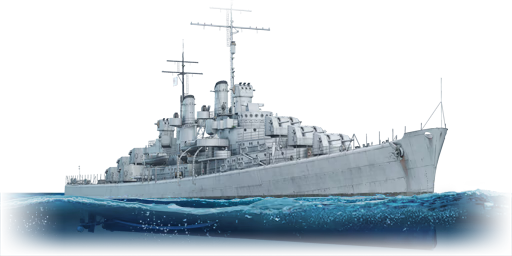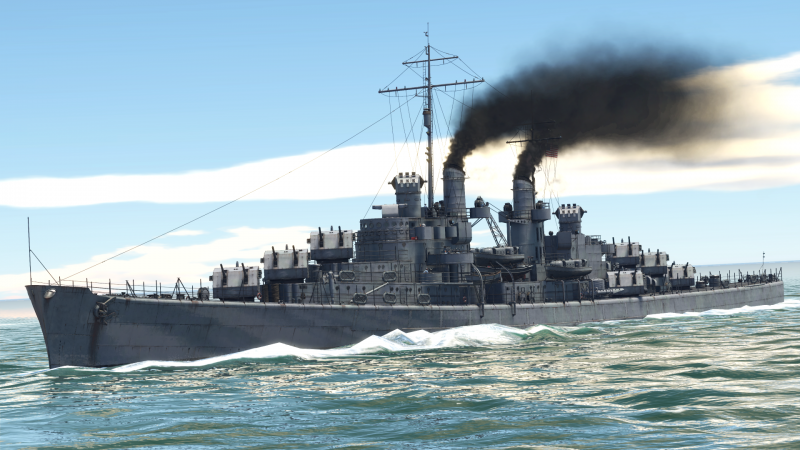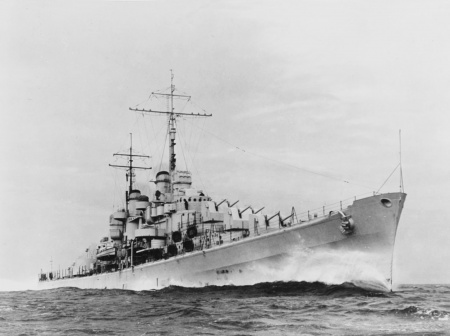Difference between revisions of "USS Atlanta"
(Edits) |
|||
| Line 20: | Line 20: | ||
<!-- ''Write about the ship's mobility. Evaluate its power and manoeuvrability, rudder rerouting speed, stopping speed at full tilt, with its maximum forward and reverse speed.'' --> | <!-- ''Write about the ship's mobility. Evaluate its power and manoeuvrability, rudder rerouting speed, stopping speed at full tilt, with its maximum forward and reverse speed.'' --> | ||
| − | Handling is surprisingly sluggish when stock. Despite the relatively low weight for a light cruiser, the Atlanta struggles to | + | Handling is surprisingly sluggish when stock. Despite the relatively low weight for a light cruiser, the Atlanta struggles to manoeuvre. Her rudder responsiveness is lethargic, and once a turn has begun, her speed dips into the 20-25 mph range. On some maps where scrambling to the island groups is necessary for lighter cruisers to evade enemy fire, the Atlanta can easily fall behind and find itself on the receiving end of heavy cruiser fire. |
{{NavalMobility}} | {{NavalMobility}} | ||
| Line 68: | Line 68: | ||
* Great gun coverage, can utilize most guns while heavily angled | * Great gun coverage, can utilize most guns while heavily angled | ||
* Effective at long-range anti-air defence when used correctly | * Effective at long-range anti-air defence when used correctly | ||
| + | |||
'''Cons:''' | '''Cons:''' | ||
* Poor survivability due to lack of armour and low crew count | * Poor survivability due to lack of armour and low crew count | ||
* Lots of turrets means a lot of ammo racks being scattered around the ship | * Lots of turrets means a lot of ammo racks being scattered around the ship | ||
| − | * Mediocre | + | * Mediocre manoeuvrability |
* Poor accuracy and weapon trajectory at longer range | * Poor accuracy and weapon trajectory at longer range | ||
* Unreliable anti-air armaments, have to rely on dual-purpose guns that is quite tricky to use at times | * Unreliable anti-air armaments, have to rely on dual-purpose guns that is quite tricky to use at times | ||
| + | |||
== History == | == History == | ||
<!-- ''Describe the history of the creation and combat usage of the ship in more detail than in the introduction. If the historical reference turns out to be too long, take it to a separate article, taking a link to the article about the ship and adding a block "/History" (example: <nowiki>https://wiki.warthunder.com/(Ship-name)/History</nowiki>) and add a link to it here using the <code>main</code> template. Be sure to reference text and sources by using <code><nowiki><ref></ref></nowiki></code>, as well as adding them at the end of the article with <code><nowiki><references /></nowiki></code>. This section may also include the ship's dev blog entry (if applicable) and the in-game encyclopedia description (under <code><nowiki>=== In-game description ===</nowiki></code>, also if applicable).'' -->[[File:USS Atlanta 1941.jpg|thumb|450x450px|The U.S. Navy light cruiser USS Atlanta (CL-51) steaming at high speed, probably during her trials, circa in November 1941.]] | <!-- ''Describe the history of the creation and combat usage of the ship in more detail than in the introduction. If the historical reference turns out to be too long, take it to a separate article, taking a link to the article about the ship and adding a block "/History" (example: <nowiki>https://wiki.warthunder.com/(Ship-name)/History</nowiki>) and add a link to it here using the <code>main</code> template. Be sure to reference text and sources by using <code><nowiki><ref></ref></nowiki></code>, as well as adding them at the end of the article with <code><nowiki><references /></nowiki></code>. This section may also include the ship's dev blog entry (if applicable) and the in-game encyclopedia description (under <code><nowiki>=== In-game description ===</nowiki></code>, also if applicable).'' -->[[File:USS Atlanta 1941.jpg|thumb|450x450px|The U.S. Navy light cruiser USS Atlanta (CL-51) steaming at high speed, probably during her trials, circa in November 1941.]] | ||
| Line 99: | Line 101: | ||
== Media == | == Media == | ||
| − | ''Excellent additions to the article would be video guides, screenshots from the game, and photos.'' | + | <!-- ''Excellent additions to the article would be video guides, screenshots from the game, and photos.'' --> |
| + | |||
| + | ;Skins | ||
| + | * [https://live.warthunder.com/feed/camouflages/?vehicle=us_cruiser_atlanta_class_atlanta Skins and camouflages for the {{PAGENAME}} from live.warthunder.com.] | ||
== See also == | == See also == | ||
| Line 110: | Line 115: | ||
<!-- ''Paste links to sources and external resources, such as:'' | <!-- ''Paste links to sources and external resources, such as:'' | ||
* ''topic on the official game forum;'' | * ''topic on the official game forum;'' | ||
| − | |||
* ''other literature.'' --> | * ''other literature.'' --> | ||
Revision as of 19:52, 17 January 2022
Contents
Description
The Atlanta-class, USS Atlanta (CL-51), 1941 is a rank American cruiser with a battle rating of (AB), (RB), and (SB). It was introduced in Update 1.91 "Night Vision".
The Atlanta-class light cruisers is specifically designed by the United States Navy as a long-range "anti-air cruiser" and fulfil its roles as the first line of defence in the "screening fleet" doctrine. As such, the USS Atlanta is equipped with a large amount of dual-purpose 5-inch (127 mm) to provide a long-range ripples of anti-air shell at an enemy aircraft. Due to the small yet numerous guns, the Atlanta is specialized in close range combat and fire support, as it is capable of oversaturate the enemy ship using its fast rate of fire before they can fight back.
General info
Survivability and armour
Ammunition storage severely lacks protection. Detonation of ammunition is commonplace, although the storage forward of the bridge does benefit from a layer of fuel storage in-between it and an incoming salvo. The turrets are equally fragile.
Mobility
Handling is surprisingly sluggish when stock. Despite the relatively low weight for a light cruiser, the Atlanta struggles to manoeuvre. Her rudder responsiveness is lethargic, and once a turn has begun, her speed dips into the 20-25 mph range. On some maps where scrambling to the island groups is necessary for lighter cruisers to evade enemy fire, the Atlanta can easily fall behind and find itself on the receiving end of heavy cruiser fire.
| Mobility Characteristics | |||
|---|---|---|---|
| Game Mode | Upgrade Status | Maximum Speed (km/h) | |
| Forward | Reverse | ||
| AB | |||
| Upgraded | |||
| RB/SB | |||
| Upgraded | |||
Modifications and economy
Armament
Primary armament
The primary armament of the Atlanta is 16 x 5 inch/38 Mk.12 (127 mm) guns in eight twin turrets, of which a maximum of 14 can be brought to bear on one target. These guns have a high rate of fire (up to 22 rounds per minute with maxed crew and first-stage ammo stowage). even with an untrained crew and have an acceptable quantity of high explosive per shell. The downside is a comparatively poor shell trajectory when compared to other cruisers; especially in fights over 8 kilometers, the five-inch guns require more precise distance input compared to larger diameter guns.
The Atlanta gets access to four shell types - Mk.34 AAC, Mk. 32 Common, Mk.46 Common SP, and Mk.31 AAVT. The Common SP (essentially a common shell with slightly less explosive mass but better penetration) is typically the best pick for heavier-armoured targets such as cruisers, while the AAC shell works better against unarmoured targets due to it's large explosive filler. The Mk.31 AAVT is a great option for dealing with air targets due to its proximity fuze - a single direct hit should be enough to destroy an incoming bomber.
Secondary armament
Despite ostensibly being an anti-air cruiser, the only "true" anti-air secondaries on the Atlanta are three quad 1.1-inch "Chicago Piano" mounts. This is due to the Atlanta were designed to utilize its numerous dual-purpose 127 mm guns to provide a long-range anti-air defense.
The 1.1 inch/75 Mk.1 Gun, otherwise known as the "Chicago Piano" (because it was the size of a baby grand-piano), was the standard anti-aircraft armament for most American ships prior to the introduction of the 40 mm Bofors cannon. These guns are mediocre at best; though they have a good fire rate (similar to the AN/M2 Browning), they aren't too effective at dealing damage, and also jam rather quickly. As well, take note that the gun doesn't have ammunition options, with just the default HE-T belt available.
Additional armament
Torpedo armament consists of six total torpedoes, three per side. The port torpedo launcher face the bow of the ship, while the starboard faces aft. This does not seriously affect usage or arcs of fire.
Usage in battles
The Atlanta is best saved for close maps like Arctic Port where her guns can eviscerate cruisers inside 6-8 km. On larger maps where cruisers engage at distances as far as 12-13 km, the Atlanta is a poor choice. She has neither the armor nor the guns to engage Hippers, Mogamis, Kirovs, or Brooklyns at longer ranges nor even the speed to place herself in a more advantageous position out of sight from the larger cruisers.
Pros and cons
Pros:
- Huge amount of dual-purposes 5 inch guns provides excellent close to medium range firepower
- Due to its high fire rate, it can quickly suppress rushing enemies attempting to close the distance
- Great gun coverage, can utilize most guns while heavily angled
- Effective at long-range anti-air defence when used correctly
Cons:
- Poor survivability due to lack of armour and low crew count
- Lots of turrets means a lot of ammo racks being scattered around the ship
- Mediocre manoeuvrability
- Poor accuracy and weapon trajectory at longer range
- Unreliable anti-air armaments, have to rely on dual-purpose guns that is quite tricky to use at times
History
USS Atlanta (CL-51) was the lead ship of her class of light cruisers built for the United States Navy during the Second World War. Designed as light anti-aircraft cruisers similar to the British Dido-class, the Atlanta was commissioned in December of 1941 just after the American entry into the Second World War. She went on to see combat action in the Pacific Theatre, and participated in the Midway and Eastern Solomons conflicts. She was later abandoned and sunk after being hit by Japanese torpedoes and friendly fire at the Naval Battle of Guadalcanal.
Design and development
The Atlanta class were designed as specialized anti-aircraft ships with armament specialized for anti-aircraft defence, similar to the British Dido-class. The ships were armed with a formidable main armament of sixteen 5-inch (127 mm) guns in eight dual mounts, with six on the centreline in two superfiring pairs and two more mounted on the beam. Despite their role, the ship’s secondary anti-aircraft armament was scarce, being limited to just three quadruple 28 mm ‘Chicago Piano’ mounts. As well, Atlanta carried two quadruple 533 mm torpedo tubes, which was unusual among American cruisers due to the doctrine of not fitting torpedo tubes to cruisers. Being a small cruiser, Atlanta displaced just 6718 tons standard and had a crew of 673. Her anti-aircraft design meant that she was an ineffective surface combatant, which would later become a fatal flaw when she was severely damaged at the Battle of Guadalcanal. Atlanta was laid down in April of 1940, and commissioned on Christmas Eve, 1941, days after the United States declared war on the Axis powers.
Operational history
After her shakedown cruise in Chesapeake bay, the Atlanta was immediately sent to the Pacific theatre, where ships of her role were badly needed. After stopping at Pearl harbour, she joined Task Force 16, under the command of Vice Admiral William ‘Bull’ Halsey, as they sailed to counter the imminent attack on Midway Atoll. At the Battle of Midway, she provided air cover for the carrier USS Hornet, while aircraft of the American force decimated the Japanese carrier group and sank all four Japanese fleet carriers.
Soon after the Midway conflict, Atlanta participated in the Battle of the Eastern Solomons, where she covered the carrier USS Enterprise as she launched her airgroup against the Japanese carriers Shokaku and Zuikaku. Soon after, she proceeded to embark Rear Admiral Norman Scott, as she became the flagship of a convoy responsible for transporting troops to Guadalcanal. They were extensively attacked by enemy aircraft during the trip, but luckily, all three troop transports emerged without severe damage. Once the transports started unloading, Atlanta provided air cover as part of the larger TF 67, covered by several other cruisers.
Soon after, the Japanese aircraft broke off, and the cruiser force enjoyed a short period of inactivity before Japanese surface units were detected. TF 67 regrouped, now being composed of the heavy cruisers San Francisco (with commanding officer RAdm Daniel Callaghan onboard), Portland and Pensacola, the light cruisers Helena, Juneau, and Atlanta, along with several destroyers. They soon engaged the Japanese force in a night engagement that resulted in the sinking of the destroyer Akatsuki and crippling of Yuudachi. However, midway into the engagement, Atlanta was hit by a Japanese ‘Long Lance’ torpedo that destroyed her engine room and knocked out most functions. Just minutes after, she was mistaken for a Japanese vessel and was hit by at least 19 8-inch shells fired by the USS San Francisco, which destroyed her superstructure and killed most of her officers including her commanding officer, RAdm Scott. The next morning, the surviving crew were disembarked by crew transports, and the ship was scuttled. The naval battle of Guadalcanal would eventually result in the sinking of her sister ship Juneau, and heavy damage to multiple other ships. For her service, Atlanta received 5 battle stars, as well as a presidential unit citation for her bravery during the Battle of Guadalcanal.
Devblog
Atlanta-class light cruisers came to being in the late 1930s, during which the US Navy was considering a multitude of different design proposals for new light cruisers, which would be in accordance with the limitations set by the Second London Naval Treaty of 1936.
Having realized that all outstanding requirements couldn't be met with a limited displacement design, the decision was eventually made to adopt a smaller light cruiser design to act as a destroyer leader. As a result, the proposed design of what would become the Atlanta-class was selected for construction, with an initial order for four ships being issued in April 1939, followed by a second order for four further vessels in September 1940.
USS Atlanta, the lead ship of the class, was laid down on 22 April 1940 in Kearny, New Jersey and was subsequently commissioned into service in December of the following year, shortly after the US' entry into WWII. Atlanta would soon receive its baptism by fire, taking part in the Battle of Midway in June 1942 while on screening duty for American aircraft carriers.
USS Atlanta also took part in heavy fighting during the Battle of the Eastern Solomons, as well as the subsequent Naval Battle of Guadalcanal. During the latter, USS Atlanta received mortal damage during a Japanese night attack, both from enemy as well as friendly fire. Although the USS Atlanta made it through the night, it became clear the next morning that the damage was too severe to deal with and the order for scuttling was issued on 13 November 1942. Atlanta was subsequently struck from the Naval Register in January of the following year.
Media
- Skins
See also
Links to articles on the War Thunder Wiki that you think will be useful for the reader, for example:
- reference to the series of the ship;
- links to approximate analogues of other nations and research trees.
External links
References
- Helgason, G. (1995). USS Atlanta. Retrieved January 26, 2021, from https://uboat.net/allies/warships/ship/2575.html
- Navy History and Heritage Command. (2019, August 20). Atlanta III (CL-51). Retrieved January 26, 2021, from https://www.history.navy.mil/research/histories/ship-histories/danfs/a/atlanta-cl-51-iii.html
| Federal Shipbuilding and Drydock Company | |
|---|---|
| Gun Destroyers (DD) | |
| Somers-class | USS Somers |
| Fletcher-class | USS Fletcher |
| Allen M. Sumner-class | USS Sumner |
| Gearing-class | USS Gearing |
| Cruiser, Light (CL) | |
| Atlanta-class | USS Atlanta |
| USA light cruisers | |
|---|---|
| Omaha-class | USS Detroit · USS Raleigh · USS Trenton |
| Atlanta-class | USS Atlanta |
| Brooklyn-class | USS Brooklyn · USS Helena |
| Cleveland-class | USS Cleveland |
| Fargo-class | USS Fargo |
| Worcester-class | USS Roanoke |







